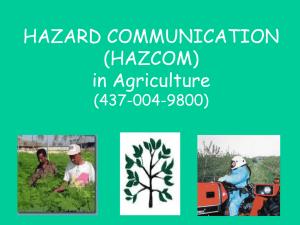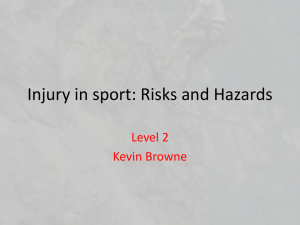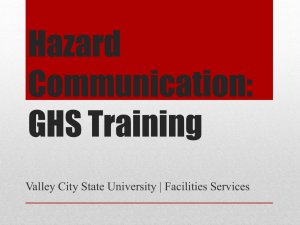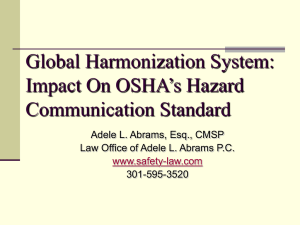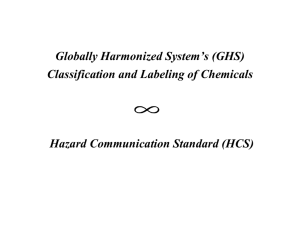hazcom & ghs
advertisement
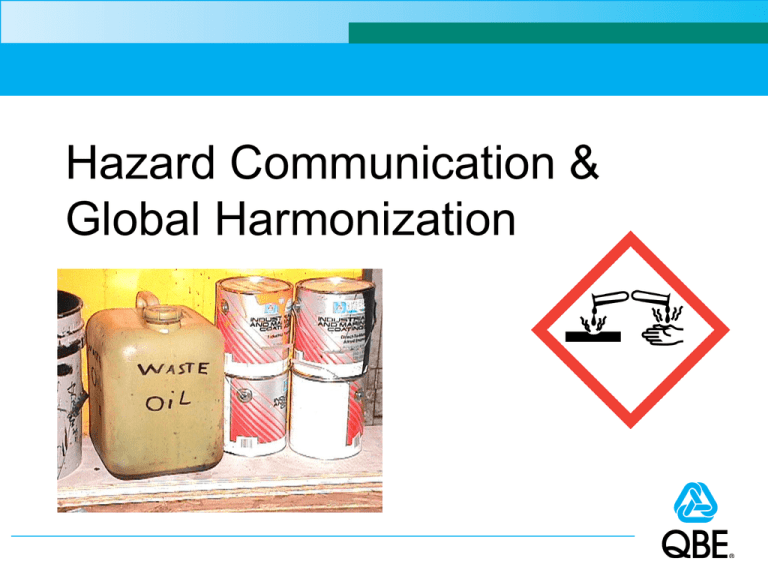
Hazard Communication & Global Harmonization Objectives • Know basic requirements of OSHA’s Hazard Communication Standard • Understand the new Global Harmonization requirements incorporated into the standard in 2012 History of Hazard Communication • Promulgated in 1983 for manufacturing only – 32 million workers exposed to chemicals – 575,000 hazardous chemicals in workplaces – 40,000 to 50,000 chemical illness each year • 1987 expanded to all industries • 2012 Global Harmonization requirements added 3 Hazard Communication • 29 CFR 1910.1200 • Also know as “Right to Know Law” or HAZCOM • Prevention of injuries and illnesses from chemical exposure • Provide knowledge of hazards to employees • Most cited OSHA standard for many years 4 Purpose • Ensure chemicals produced or imported evaluated • Ensure the hazards of chemicals are transmitted to employers and employees • Ensure consistency in evaluation and classifying hazards 5 Does not apply to: • • • • • • • • • • • Hazardous waste Tobacco Wood products that are not hazardous Articles Food or alcohol Drugs Cosmetics Consumer products Nuisance particles Ionizing and non-ionizing radiation Biological hazards 6 Who Is Responsible? • • • • Chemical Manufacturers Importers & Distributors Employers Employees Chemical Manufacturers & Importers • Determine hazards of products • Communicate information to customers through labels and SDSs (Safety Data Sheets) 8 Employers • • • • Identify and list chemicals in workplace Obtain and retain SDSs for each chemical Label secondary containers Develop written Hazard Communication Program • Provide personal protective equipment • Train employees 9 Employees • Comply with company’s written Hazard Communication Program • Follow warnings and cautions on labels and SDS’s • Wear appropriate PPE as required • Prepare hazard labels for new containers when hazardous materials are transferred from manufacturers containers 10 Employee Training • How the company’s HAZCOM Program is implemented • Hazards of chemicals in their work area • Measures to take to protect themselves • Location of PPE • Methods and observations workers can use to detect the presence of a chemical 11 Labels and Warnings • Each chemical container must be labeled, tagged or marked with identity of the chemical and its hazards • Labels must be in English and prominent 12 SDSs • Developed by chemical manufacturer or importer • Must be provided with each shipment of chemicals • Must provide information about the chemical including hazards 13 Chemical Inventory • Include all hazardous substances as well as potentially hazardous materials • Consider all physical forms of chemicalsliquids, solids, gases, vapors, fumes, and mists • Identify chemicals in containers including pipes • Include chemicals generated by processes such as welding fumes, dusts, and exhaust fumes Created Chemical Hazards Global Harmonization System- GHS • GHS refers to the United Nations Globally Harmonized System of Classification and Labeling of Chemicals • Initiated at UN Conference in Rio de Janeiro in 1992 • Standardizes definitions of health, physical and environmental data • Standardizes hazard classification • Standardizes hazard communication GHS Benefits • Enhances protection of human health and the environment • Reduces need for duplicative testing of chemicals • Increases efficiency by reducing cost of regulatory compliance 17 Changes to OSHA’s HAZCOM Standard • • • • Minimal MSDSs now SDSs (Safety Data Sheets) “Right to Know” now “Right to Understand” OSHA Defined Hazards not in GHS 1. 2. 3. 4. • • Pyrophoric gas Simple asphyxiant Combustible Dust Hazard Not Otherwise Classified (HNOC) No more 1% rule Some chemicals not hazardous in past may be hazardous now and vice versa 18 GHS Physical Hazards • • • • • • • • Explosives Flammable gases Flammable aerosols Oxidizing gases Gases under pressure Flammable liquids Flammable solids Self-reactive substances and mixtures • Organic peroxides • Corrosive to metals • Self-heating substances and mixtures • Pyrophoric liquids • Pyrophoric solids • Substances and mixtures which, in contact with water, emit flammable gases • Oxidizing liquids • Oxidizing solids • Pyrophoric gases (OSHA) • Combustible dusts (OSHA) • Hazard Not Otherwise Classified (HNOC) (OSHA) GHS Health Hazards • Acute toxicity • Skin corrosion/irritation • Serious eye damage/irritation • Respiratory or skin sensitization • Germ cell mutagenicity • Carcinogenicity • Reproductive toxicity • Specific target organ toxicity • Aspiration hazard • Simple asphyxiant (OSHA) 20 GHS Environmental Hazards • Permitted by OSHA but not required – Aquatic toxicity – Hazardous to the ozone layer 21 Hazard Classification • Data for chemicals compared to criteria and definitions in Appendices of OSHA standard. • Example – Pyrophoric solid – Appendix B- Physical Hazard Criteria Category 1 if the solid ignites within 5 minutes of coming in contact with air – Appendix C- Allocation of Label Elements Signal Word- “Danger” Hazard Statement- “Catches fire spontaneously if exposed to air.” Precautionary Statements- “Do not allow contact with air.” 22 Labels 23 Label Content Shipped Containers • • • • • • Product identifier Signal word (Danger or Warning) Hazard statement Pictogram Precautionary Statement Name, address and phone number of manufacturer or supplier 24 Signal Words or • Danger- More severe hazards • Warning- Less severe hazards Pictograms • Nine pictograms under GHS • Eight pictograms adopted by OSHA (environmental not adopted) • Red border, black symbol, white background 26 Exploding Bomb Pictogram • Explosives • Self-reactives • Organic peroxides 27 Flame Pictogram • • • • • Flammables Self-Reactives Pyrophorics Self-Heating Emits Flammable Gas • Organic peroxides 28 Flame over Circle Pictogram • Oxidizers 29 Gas Cylinder Pictogram • Gases under Pressure 30 Corrosion Pictogram • Corrosive to metal • Corrosive to skin • Corrosive to eyes 31 Skull & Crossbones Pictogram • Severe acute toxicity 32 Exclamation Mark Pictogram • Irritant • Skin sensitizer • Less severe acute toxicity • Narcotic effects • Respiratory irritation 33 Health Hazard Pictogram • Carcinogen • Respiratory sensitizer • Reproductive toxin • Target organ toxicity • Mutagen • Aspiration hazard 34 Environment Pictogram • Environmental hazard 35 Hazard Statement • Standardized harmonized statement • Chosen from tables in Appendix C, based on the chemical classification • Example Flammable Liquids – Category 1: Extremely flammable liquid and vapor – Category 2: Highly flammable liquid and vapor – Category 3: Flammable liquid and vapor – Category 4: Combustible liquid 36 Precautionary Statement • Standardized statements that supplement information on the label. • Chosen from tables in Appendix C, based on the chemical classification • Four types– Prevention – Emergency Response – Storage – Disposal 37 New Label Example 38 In-House GHS Labels • Labels will be required to have 5 parts: 1. 2. 3. 4. 5. Product identifier Pictogram Signal words Hazard statement Precautionary statement or Product identifier and words, pictures, symbols or combinations, which provide employees with specific information regarding the physical and health hazards of hazardous chemicals Hazardous Materials Identification System- HMIS GHS SDS Sections 1. 2. 3. 4. 5. 6. 7. 8. Identification Hazard Identification Composition/Info on Ingredients First Aid Measures Fire Fighting Measures Accidental Release/Spills Handling & Storage Exposure Controls/PPE GHS SDS Sections (continued) 9. Physical/Chemical Properties 10. Stability/Reactivity 11. Toxicological Info. 12. Ecological Info. 13. Disposal Considerations 14. Transport Info. 15. Regulatory Info. 16. Other Information Effective Dates • Final Rule Effective – July 2012 • Employers must train employees of the new labels and SDS formats by 12/31/2013 • Manufacturers, importers, distributors and employers must comply by 6/1/15 • Distributors cannot ship containers with noncompliant labels after 12/1/15 • Employers must update HAZCOM Programs and provide additional training on new hazards by 6/1/2016 44 What should employers be doing? • Read and understand new hazard classifications • Review and update SDSs for changes in hazards • Assess workplace controls is light of new classifications • Review and update HAZCOM Program • Review and update in-house labeling • Keep list of hazardous chemicals up-to date • Train employees in new labels • Train employees in changes to SDSs • Train employees is new hazard classifications 45 Other Resources • OSHAhttp://www.osha.gov/dsg/hazcom/index.html • UNhttp://www.unece.org/trans/danger/publi/ghs/ghs_ welcome_e.html • Society for Chemical Hazard Communicationhttp://www.schc.org 46




